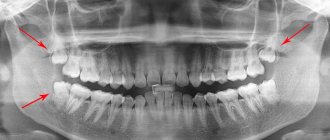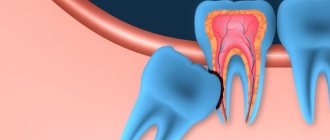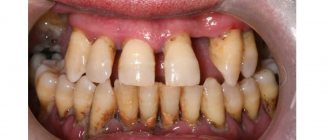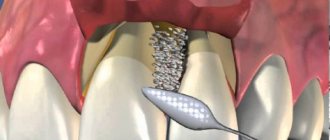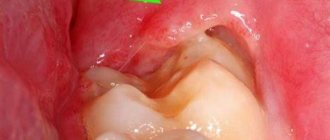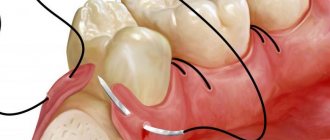The article was prepared by orthopedic dentist Diana Levchuk.
To decide whether to treat a tooth or remove it, the patient needs to consult a dentist. The dentist-therapist, from the height of his qualifications and experience, assesses whether he can save the tooth or not.
But there are borderline cases when it is impossible to guarantee the success of treatment and the decision to fight for the tooth or not remains with the patient.
Tooth extraction, in modern dentistry, is considered an extreme form of treatment.
Now everything is being done to save the tooth, because a well-treated tooth can serve you for a very long time. And you will always have time to place an implant.
Often the doctor proactively tries to save a “hopeless tooth”; this is not always approved by the clinic’s management, because it is much easier and more profitable to quickly remove a tooth and place an implant, but a “saved tooth” must be guaranteed, which is not always possible.
If you meet a doctor who offers several treatment options and tries to save the tooth, he is definitely a good doctor; you will always have time to remove the tooth.
It is a myth that an implant completely replaces a tooth. Under the implant, the bone dissolves, although not as quickly as without it, the gums recede, and food begins to get under the crown. Over time, the list of inconveniences expands, so your own tooth must be preserved for as long as possible.
Modern dentistry makes it possible to treat teeth without pain, a huge selection of modern aesthetic materials and a sufficient amount of time allows the doctor to significantly improve the patient’s quality of life and provide a level of treatment that was previously unimaginable.
A dentist can give a recommendation for tooth extraction only after a thorough examination and x-ray. To reduce the risk in the treatment of “complex” teeth, the most modern technologies are used, and the treatment of complex teeth is carried out under a microscope .
Until recently, for example, a cyst on a tooth was an indisputable argument in favor of removal. Now there are drugs that stimulate bone growth and stop the inflammation process.
How to remove a tooth
There are two extraction methods used in dentistry: simple and complex. Their choice depends on which teeth are being removed - premolars and molars with tangled branched roots are removed using a complex method. It is very difficult to pull out such elements entirely due to the fact that the tooth socket is penetrated by retaining ligaments and alveolar processes. Errors during the procedure or insufficient experience of the specialist lead to serious complications. Therefore, even despite the acute condition, always find out in advance where you can have a tooth removed from a good doctor with positive recommendations.
Factors complicating the operation:
- complete destruction of the coronal part;
- high fragility;
- acute inflammatory diseases;
- Unerupted or misaligned wisdom teeth.
The technology of the procedure depends on which teeth are removed. In some cases, tissue incision and suturing are performed.
Whether it is painful to remove a tooth or not depends largely on the condition of the element. Anesthesia is performed in all cases, with the exception of severe allergic reactions to all types of painkillers. With the development of extensive purulent lesions, the effect of the drug may be reduced.
How long it takes to remove a tooth depends on the complexity of the operation. On average, this takes no more than 5-10 minutes (including waiting for the anesthesia to take effect). In general, the procedure includes the following steps:
- anesthesia;
- if necessary, an incision is made into the mucous membrane to access the cervical area, or the doctor lowers the gum with an instrument;
- Use forceps to fix the tooth at the lowest point without excessive pressure;
- rocking and extraction from the hole is performed;
- returning the gum flap to its place.
If inflammatory processes are diagnosed in the oral cavity, a course of antibiotics is prescribed. In some cases, extraction is performed under general anesthesia.
In case of multiple lesions, the doctor determines how many teeth can be removed in your case during one visit, but more often it is 1–2 elements. This is because extraction is a traumatic operation that will take time to recover from. Too large areas of damage increase the likelihood of complications several times and take much longer to heal.
If after surgery the extracted tooth, or rather the hole left after it, hurts, this is a reason to consult a doctor. After the procedure, minor pain is allowed during the first 24 hours. Visit the dentist if your temperature rises, swelling increases, bleeding occurs, or pain spreads to the lymph nodes. These are symptoms of a wound infection. Untimely treatment can lead to alveolitis.
Content:
- When you should not remove a wisdom tooth 1.1. There is no need to touch a healthy “eight” 1.2. The unit does not interfere, it stands in its place 1.3. The third molar can be treated without problems 1.4. Wisdom teeth - as a replacement for missing neighbors
- When you can't do without deletion 2.1. Remote location 2.2. Pressure on “neighbors” 2.3. Inability to install braces 2.4. The rudiment injures the cheeks and gums 2.5. Partial eruption
Today, dentists believe that third molars are unnecessary evidence that the ancestors of modern humans had very massive and large jaws.
They are rudiments that do not carry a significant functional load. Most scientists are sure that “eights” are superfluous in the dentition, since the food consumed is easy to chew. But is it necessary to remove wisdom teeth? No one does surgery just like that. There are certain medical conditions in which the doctor performs a tear. If the unit can be saved, the doctor tells how to treat it correctly. In other words, despite the rudimentary nature of the “eights,” no one should rush to get rid of them, if only because this operation is complex and traumatic.
Wisdom tooth removal
Wisdom teeth are considered full-fledged elements of the oral cavity. They are involved in chewing food (if they are located above each other and have contact), and can act as a support for bridges and removable dentures in the future. There are specific indications for extraction in their case. For this reason, the decision about whether wisdom teeth need to be removed is made only by the attending physician.
The most common problem with eighth teeth is their growth. Only some teeth form and grow completely without complications, but often these processes are accompanied by a number of difficulties:
- semi-retinated or impacted elements that have formed in the bone tissue, but have not erupted or only partially erupted. Their position can be vertical, horizontal, or with their roots outward. Because of this, neighboring elements suffer, constant pain appears;
- violation of position (dystopia). Since wisdom teeth erupt without predecessors (baby teeth), and the jaw bone is already formed and does not develop, the position of the elements is often incorrect. They injure the mucous membrane, overlap other crowns, and put pressure on neighbors. This leads to inflammation. The doctor will determine whether the position can be restored with orthodontic treatment or whether it is better to remove the wisdom tooth;
- appearance of a gingival hood. When slowly cutting through the mucosa, an area is formed in which bacteria and food debris accumulate, which are difficult to clean. This leads to acute inflammation, which can provoke the appearance of pus;
- destruction, caries. Elements may appear immediately underdeveloped with carious lesions.
The doctor determines whether wisdom teeth should be removed or not based on complaints and the clinical picture. Problems with even one or two teeth interfere with the normal functioning of the entire dental system. Pain appears when opening the mouth and chewing. The bite and position of the incisors may even change.
How a wisdom tooth is removed depends, as in the case of permanent elements, on the condition of the dental system. In the absence of contraindications, manipulation is carried out with ordinary forceps.
Whether it is painful to remove a wisdom tooth depends on the presence or absence of purulent formations. If they are present, then the painful sensations may persist even after pain relief. Most often, classical infiltration anesthesia is used, which covers a large area and maintains the effect for a long time.
When is it necessary to remove a tooth?
Since tooth extraction is a serious surgical intervention, dentists try to preserve the patient’s teeth to the last. Modern dentists resort to removal only in the most extreme cases, when the tooth is not able to withstand the chewing load, or the nerve or mucous membrane is injured. Also, a tooth has to be disposed of if it cannot become a support for the prosthetics needed by the patient. The most common arguments for deletion are the following situations:
- Periodontitis in the acute stage, when to eliminate the source of infection it is necessary to pull out the diseased tooth;
- A tooth crown broken at the root;
- Osteomyelitis of the jaw, when elimination of the problematic tooth becomes the only way to get rid of the infectious focus;
- Chronic diseases and periodontitis of baby teeth;
- Significant carious destruction that does not allow saving the tooth;
- Difficult eruption of the figure eight or its incorrect location, which is dangerous for neighboring molars, can become a reason for the removal of a wisdom tooth;
- Problems with the root of the tooth that cannot be treated.
Root removal
How is the root of a tooth removed if the tooth is completely destroyed? Despite this situation, extraction is not always recommended. If, after diagnosis, the doctor determines that the root can be used for an inlay, then the tooth is restored with a crown. But if there is pain, an unpleasant smell and taste, or swelling has developed, then dental care is required urgently. In this case, the question of whether to remove the roots of the teeth is decided in favor of the operation, since the neglected condition can also lead to the loss of neighboring elements.
Regardless of the chosen technique, pain relief and X-ray control are required after removal. This allows you to make sure that there are no root fragments in the cavity, since it is often loose and can crumble under slight pressure from the forceps.
Treat a tooth: is it really necessary?
Naturally, treating a neglected tooth that hurts for days costs an order of magnitude more than removing it and may require several visits to the doctor. But compared to implantation and prosthetics, which follow removal, treatment is much cheaper.
True, there are cases with absolute indications for removal: such as tooth destruction at the root level, when after removing all damaged tissue, it cannot be restored either with a filling, or an inlay, or a crown.
Therefore, it is right for everyone to undergo regular dental examinations and not lead to deep tooth decay.
Recommendations after removal
Regardless of which tooth you removed or just its root, you must follow the rules of the rehabilitation period. Then healing takes place quickly and without complications.
- Do not eat for 2-3 hours after surgery.
- Eliminate hot and solid foods from your diet for 7 days.
- Carefully walk around the socket when brushing your teeth.
- Do not pick out the blood clot and try not to disturb the hole with your tongue until it is completely healed.
- Don't rinse your mouth.
The Vimontal Clinic carries out operations of any complexity using advanced equipment. This allows you to provide assistance with maximum comfort and safety.
How to treat toothache
Tooth extraction or extraction is a forced measure that the dentist resorts to if a baby or permanent tooth is severely damaged and the patient experiences severe pain when chewing.
Also, the radical method is suitable for patients who are not ready for expensive and lengthy treatment, or who want to install an implant or a prosthesis. Often, the doctor removes a healthy molar, for example, when it is curved, displaced or grows incorrectly and interferes with prosthetics. From the article on the website Stom-Firms.ru you will learn when a tooth is treated, what are the indications for its removal and how to preserve it.
Surgical options
Before the procedure, the doctor must collect anamnesis and conduct tests, because in the presence of allergies, diabetes, cancer and other diseases, treatment has some nuances. The location and shape of the third molar are studied using x-rays. The more severe the operation, the longer and more uncomfortable the rehabilitation period will be.
There is a risk of complications in the form of alveolitis and a feeling of numbness in the mouth. To avoid infection, do not rinse your mouth immediately after wisdom tooth removal. If any consequences appear that the doctor did not warn about, you should rush to a dental consultation.
Surgical options:
- Simple. Duration – up to 15 minutes. It is carried out for the top eight without developmental disabilities. The patient is given local anesthesia, after which the tooth is loosened and pulled out of the socket with forceps. The gums are sutured and treated with an antiseptic.
- Complex. Duration – up to 2 hours. It is performed on the lower jaw to remove third molars with a destroyed crown, defective structure and/or branched roots. The patient is given a local anesthetic, after which an incision is made in the gum and the bone tissue is drilled out. The wound is sutured and then disinfected.
Why treat baby teeth
Children's teeth are less hard than adult teeth. Therefore, diseases develop rapidly in them. Caries can turn from a small dark spot into a deep cavity in a few weeks, and then it’s not far from pulpitis.
Pulpitis in baby teeth is also dangerous precisely because of its rapid development. After several days of toothache, the disease becomes chronic. The tooth stops hurting, but the inflammatory process continues, which is fraught with very serious consequences. And in this case, the question of whether to treat a baby tooth or remove it can only be decided by a doctor.
Therefore, if you do not want to face more serious problems, try to have your child meet with the dentist in a timely manner, and never consider the removal of temporary teeth as an alternative to treatment.
Molar tooth extraction in children
Unfortunately, young children often develop diseases in both their primary and permanent molars. Worse, it is not always possible to heal them. Dentists remove permanent teeth for children only when there is no way to save them.
Primary molars are both treated and removed. If a permanent tooth begins to grow under a baby molar, then the baby tooth is always removed, since it interferes with the normal formation of the permanent tooth.
At the same time, dentists never agree to premature removal of baby molars. Such teeth are sure to heal. If you remove a baby tooth ahead of schedule, then the baby will develop a crooked bite.
There are situations when a child’s molar tooth must be removed. Such situations include:
- molar root cyst;
- presence of granuloma;
- inflammation of the tooth root;
- inflammation of the nerve of the lower jaw;
- severe destruction of the integrity of the tooth.
Is it possible to remove a molar tooth yourself?
Trying to remove a molar tooth yourself is extremely dangerous. The only exception is very severe tooth looseness. It should be borne in mind that complete removal even in this situation will not work. You will simply break off the body of the tooth from the root, and nothing more. In any case, after such an independent removal, you need to visit a dentist, who will determine what should be done next. Sometimes an artificial tooth is installed at the root, and it can last for more than one year. If the root has defects, then it has to be removed.
There are situations when you have to remove a child’s very loose baby tooth at home. In this case, you should thoroughly brush the baby’s teeth and disinfect the oral cavity. Then you should wrap your fingers in sterile gauze, loosen the tooth thoroughly, and only then try to pull it out. If this was not possible on the second attempt, then the child must be taken to the dental clinic in any case.
If you have successfully removed the tooth from the socket, then you must firmly place a gauze swab in the socket and leave it there for 30 - 40 minutes. In the next two hours, the child should not be allowed to eat or drink.
Even if the removal was successful, the baby still needs to be shown to the dentist. This is the only way to protect your child from possible complications.
Removal of molars during pregnancy
Let us say right away that any surgical intervention during pregnancy is extremely undesirable. If a molar tooth hurts at this time, then ideally it would be best to simply heal it. Unfortunately, sometimes this is no longer possible and the diseased tooth has to be removed.
It is highly undesirable to remove molars in the first and last months of pregnancy. It is at this time that the fetus is most vulnerable.
If it is possible to postpone the removal of a molar until the birth of the child, then this is exactly what should be done.
Under no circumstances should you hide your pregnancy from your dentist. On the contrary, this should be said immediately. In this case, the doctor will select a harmless anesthetic that will not cross the placental barrier.
If a pregnant woman is facing a complex molar tooth extraction, then this should only be done in a hospital setting. After removal, the patient should be under medical supervision for at least two to three days. This is due to the fact that very often, after the removal of a molar, pregnant women experience a sharp increase in body temperature, and this is extremely harmful for the fetus.
